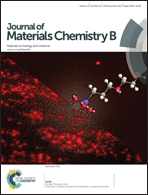Novel protein-loaded chondroitin sulfate-N-[(2-hydroxy-3-trimethylammonium)propyl]chitosan nanoparticles with reverse zeta potential: preparation, characterization, and ex vivo assessment†
Abstract
A facile polyelectrolyte complexation method for the preparation of both positively and negatively surface charged nanoparticles composed of chondroitin sulfate (ChS) and N-[(2-hydroxy-3-trimethylammonium)propyl]chitosan (HTCC) is reported. Production of ChS–HTCC nanoparticles with reverse zeta potential was easily controlled by varying the ChS/HTCC mass ratio. The encapsulation efficiency increased with the increase in initial FITC–BSA concentration in positively charged NPs and reached 75%. However, a maximum of 20% encapsulation efficiency was achieved in the case of negatively charged NPs. In vitro release studies of positively charged ChS–HTCC NPs showed a small burst effect followed by a continued and controlled release. Both charges of ChS–HTCC NPs showed no cytotoxicity in HUVECs. The confocal images showed that ChS–HTCC NPs of both charges can be incorporated and retained by the A549 cells. Flow cytometric analysis data demonstrated that ChS–HTCC NPs of both charges were detected in more than 80% of the A549 cells.
![Graphical abstract: Novel protein-loaded chondroitin sulfate-N-[(2-hydroxy-3-trimethylammonium)propyl]chitosan nanoparticles with reverse zeta potential: preparation, characterization, and ex vivo assessment](/en/Image/Get?imageInfo.ImageType=GA&imageInfo.ImageIdentifier.ManuscriptID=C5TB01517K&imageInfo.ImageIdentifier.Year=2015)
- This article is part of the themed collection: 2015 Journal of Materials Chemistry B Hot Papers

 Please wait while we load your content...
Please wait while we load your content...